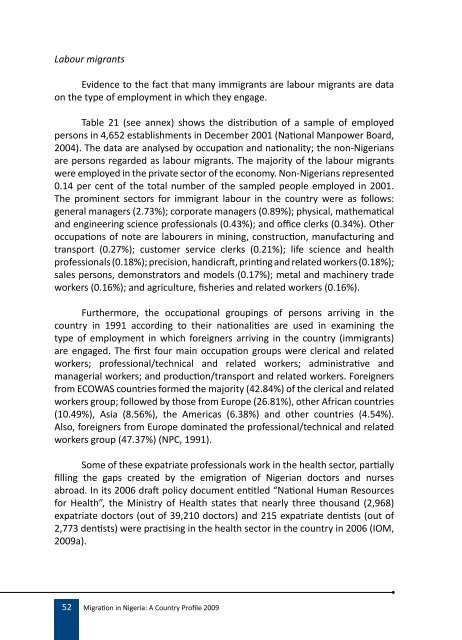Migration Profile on Nigeria - IOM Publications - International ...
Migration Profile on Nigeria - IOM Publications - International ...
Migration Profile on Nigeria - IOM Publications - International ...
Create successful ePaper yourself
Turn your PDF publications into a flip-book with our unique Google optimized e-Paper software.
Labour migrants<br />
Evidence to the fact that many immigrants are labour migrants are data<br />
<strong>on</strong> the type of employment in which they engage.<br />
Table 21 (see annex) shows the distributi<strong>on</strong> of a sample of employed<br />
pers<strong>on</strong>s in 4,652 establishments in December 2001 (Nati<strong>on</strong>al Manpower Board,<br />
2004). The data are analysed by occupati<strong>on</strong> and nati<strong>on</strong>ality; the n<strong>on</strong>-<strong>Nigeria</strong>ns<br />
are pers<strong>on</strong>s regarded as labour migrants. The majority of the labour migrants<br />
were employed in the private sector of the ec<strong>on</strong>omy. N<strong>on</strong>-<strong>Nigeria</strong>ns represented<br />
0.14 per cent of the total number of the sampled people employed in 2001.<br />
The prominent sectors for immigrant labour in the country were as follows:<br />
general managers (2.73%); corporate managers (0.89%); physical, mathematical<br />
and engineering science professi<strong>on</strong>als (0.43%); and office clerks (0.34%). Other<br />
occupati<strong>on</strong>s of note are labourers in mining, c<strong>on</strong>structi<strong>on</strong>, manufacturing and<br />
transport (0.27%); customer service clerks (0.21%); life science and health<br />
professi<strong>on</strong>als (0.18%); precisi<strong>on</strong>, handicraft, printing and related workers (0.18%);<br />
sales pers<strong>on</strong>s, dem<strong>on</strong>strators and models (0.17%); metal and machinery trade<br />
workers (0.16%); and agriculture, fisheries and related workers (0.16%).<br />
Furthermore, the occupati<strong>on</strong>al groupings of pers<strong>on</strong>s arriving in the<br />
country in 1991 according to their nati<strong>on</strong>alities are used in examining the<br />
type of employment in which foreigners arriving in the country (immigrants)<br />
are engaged. The first four main occupati<strong>on</strong> groups were clerical and related<br />
workers; professi<strong>on</strong>al/technical and related workers; administrative and<br />
managerial workers; and producti<strong>on</strong>/transport and related workers. Foreigners<br />
from ECOWAS countries formed the majority (42.84%) of the clerical and related<br />
workers group; followed by those from Europe (26.81%), other African countries<br />
(10.49%), Asia (8.56%), the Americas (6.38%) and other countries (4.54%).<br />
Also, foreigners from Europe dominated the professi<strong>on</strong>al/technical and related<br />
workers group (47.37%) (NPC, 1991).<br />
Some of these expatriate professi<strong>on</strong>als work in the health sector, partially<br />
filling the gaps created by the emigrati<strong>on</strong> of <strong>Nigeria</strong>n doctors and nurses<br />
abroad. In its 2006 draft policy document entitled “Nati<strong>on</strong>al Human Resources<br />
for Health”, the Ministry of Health states that nearly three thousand (2,968)<br />
expatriate doctors (out of 39,210 doctors) and 215 expatriate dentists (out of<br />
2,773 dentists) were practising in the health sector in the country in 2006 (<strong>IOM</strong>,<br />
2009a).<br />
52 <str<strong>on</strong>g>Migrati<strong>on</strong></str<strong>on</strong>g> in <strong>Nigeria</strong>: A Country <str<strong>on</strong>g>Profile</str<strong>on</strong>g> 2009

















